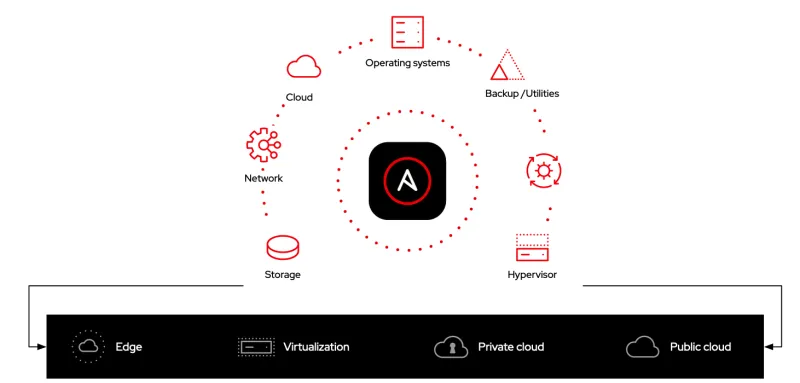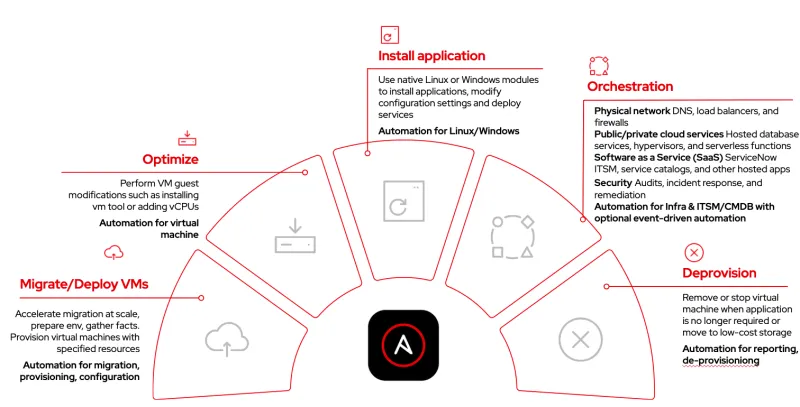Virtualization has been a key underlying technology for critical business applications. At its inception, virtualization improved hardware utilization, made IT more efficient and helped reduce costs. As a result, virtual infrastructure became an important part of IT operational technologies, and it remains in use today for many of the same reasons.
A variety of business applications run in virtualized environments. As with other components of the IT stack, they need to be managed. But virtual machines (VMs) are only part of the equation. There's a host of related infrastructure which can vary based on the needs of the application. This can include everything from network connectivity and storage, to security and identity management tools, to observability and backup solutions, to cloud instances and on-premises servers, and the list goes on!

Management must take place across the full operational lifecycle including provisioning, ongoing management, security checks and issue resolution, and final sunsetting of unused VMs. This full lifecycle has to be completed for the VMs and the related infrastructure. What if you could automate and orchestrate multi-domain team collaboration such as application deployments, inventory updates or security tool integration? How much more efficient, accurate and consistent would your process be?
Automation efficiency, consistency and accuracy
When you use automation across the full virtual infrastructure, efficiency is dramatically improved. Just in provisioning alone, one customer was able to reduce a costly vendor process that previously took 20 hours. By using Red Hat Ansible Automation Platform instead, they were able to complete the same work in only 30 minutes for each VM.
Additional benefits include consistency and accuracy so that the desired actions for your virtual infrastructure are the same no matter when and where they are completed and by whom. All of your actions are captured as an audit trail, making it easy to share with security and compliance teams. If you are facing skills gaps or a shortage of resources, this can be an important benefit. By freeing teams from repetitive, high volume work, they can instead focus on interesting engineering challenges and key priorities that deliver value to your operation and your business.
Automate virtual infrastructure management across the lifecycle
Let’s explore how you can automate management across the virtual infrastructure and across the lifecycle. The image below summarizes what you can do to manage virtual infrastructure with the efficiency of automation.

You can automate processes across the areas that span your full lifecycle for virtualization:
- Provision and configure: Use a single source of truth to provision new VMs that align to your standards and compliance needs, or even implement self-service provisioning of VMs that meet certain pre-defined criteria
- Orchestrate: Use automation to streamline collaboration across steps in the provisioning or management process to save time, for example to connect the VM to a load balancer as part of a workflow, automate backup processes or integrate inventory updates as part of the provisioning process
- Manage security and compliance: Rapidly complete requirements, from registering a new VM in security and identity management tools to completing security checks, to automating the response to new security alerts
- Automate responses: Create automation for desired actions when alerts are present, such as adjusting storage, fact gathering for service tickets to expedite MTTR, or taking basic actions such as adjusting vCPU and memory or restarting a service
- Enable continuity: Automate steps across a complex continuity process including taking snapshots, stopping applications, provisioning a failover solution, moving workloads and more
- Automate related infrastructure: Manage network connectivity and enable compliance, manage storage size with automated response to thresholds limits, and manage other factors that matter for your operation, such as application security, database health, or backup and restore solutions
- Migrate at your own pace: Use automation to migrate a group of VMs at scale as your organization sets new strategies for operating existing VMs and/or modernizing these workloads to cloud-native applications
This is a rich topic area, with much more to explore. Your teams can listen on demand to our automation expert’s webinar covering this full lifecycle automation solution.
Enterprise automation tackles virtual infrastructure and much more
Virtual infrastructure is complex, but you may also have cloud-native applications running in containers, possibly across hybrid cloud or multi-cloud environments, as well as edge and IoT applications. Each brings its own set of management challenges. AI is now being added, with its own set of additional data and processing demands. Sound like a lot to manage? It is.
An enterprise automation strategy can go a long way to ensuring your team's success across simultaneous operational needs. Conquer all of these requirements with a common automation platform to manage and orchestrate within and across the IT processes that matter to your organization. Utilizing a common language and a common toolset helps break down silos and improve efficiency. Automating a single process is great, but automating the full process provides the best experience for the end users.
One of the most effective approaches is combining an enterprise automation strategy with an automation-first mindset or culture, with Ansible Automation Platform as a common, flexible automation foundation for any IT management challenge.
Red Hat sponsored a recent paper with the Futurum Group where they share ideas in this area:
“As an enterprise automation strategy is developed, organizations should first conduct a comprehensive review of the organization’s current IT environments. Doing so can help identify legacy systems in need of modernization, infrastructure bottlenecks, and areas that could benefit from optimization. By gathering a holistic view of the organization, the implementation of automation strategies can maintain alignment with long-term objectives and can be prioritized for maximum impact. “
Review this paper to understand at a high level how an enterprise automation strategy can help you operate seamlessly despite these challenges.
Additional resources
Product trial
Red Hat Ansible Automation Platform | Product Trial
About the author
Cindy Russell is a Senior Principal Product Marketing Manager for Ansible Automation Platform.
More like this
Slash VM provisioning time on Red Hat Openshift Virtualization using Red Hat Ansible Automation Platform
Red Hat Ansible Automation Platform: Measuring Business Impact with Dashboard and Analytics
Technically Speaking | Taming AI agents with observability
Transforming Your Identity Management | Code Comments
Browse by channel
Automation
The latest on IT automation for tech, teams, and environments
Artificial intelligence
Updates on the platforms that free customers to run AI workloads anywhere
Open hybrid cloud
Explore how we build a more flexible future with hybrid cloud
Security
The latest on how we reduce risks across environments and technologies
Edge computing
Updates on the platforms that simplify operations at the edge
Infrastructure
The latest on the world’s leading enterprise Linux platform
Applications
Inside our solutions to the toughest application challenges
Virtualization
The future of enterprise virtualization for your workloads on-premise or across clouds
